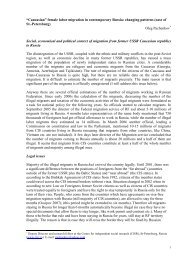THORIUM AS AN ENERGY SOURCE - Opportunities for Norway ...
THORIUM AS AN ENERGY SOURCE - Opportunities for Norway ...
THORIUM AS AN ENERGY SOURCE - Opportunities for Norway ...
Create successful ePaper yourself
Turn your PDF publications into a flip-book with our unique Google optimized e-Paper software.
Thorium as an Energy Source - <strong>Opportunities</strong> <strong>for</strong> <strong>Norway</strong><br />
The AHWR fuel cycle will be implemented in stages – starting with the fuel cycle of “AHWR<br />
Critical Facility” which is being built at BARC followed by a closed fuel cycle of AHWR which will<br />
ultimately be self-sustaining with respect to U-233. The initial core will be made up entirely of<br />
(Th, Pu-239) MOX fuel assemblies, each being made of 54 fuel pins. Successively, the U-233 bred<br />
in the (Th, Pu-239) MOX fuel will be recovered and recycled as (Th, U-233) MOX. At equilibrium,<br />
the core of the AHWR will consist of composite fuel assemblies each having 24 (Th, Pu-239) MOX<br />
pins and 30 (Th, U-233) MOX pins arranged in three consecutive rings having fissile material<br />
compositions:<br />
1st ring (inner ring): 12 pins consisting of (Th,U-233)O2 with U-233 enrichment of 3.0wt%.<br />
2nd ring (intermediate): 18 pins consisting of (Th,U-233)O2 with U-233 enrichment of 3.75wt%.<br />
3rd ring (outer ring): 24 pins consisting of (Th,Pu)O2 with Pu enrichment of 3.25wt%.<br />
The content of fissile plutonium isotopes will go down from an initial 75 % to 25 % at the<br />
equilibrium discharge burn-up level. However, to reduce the overall inventory of the waste, it is<br />
envisaged that thorium and U-233 will be recycled in the AHWR. Even though U-234 produced<br />
(along with U-235 and U-236) by neutron capture in U-233 has a negative influence on reactivity,<br />
it might be possible to recycle U-233 in AHWR with only a marginal penalty of less than 1000<br />
MWd/tHM on discharge burn-up <strong>for</strong> each recycling.<br />
The objective was to achieve a negative void coefficient of reactivity with light water as a coolant<br />
[62]. The core was optimized with respect to the fissile content, the maximum attainable<br />
reactivity, and low power peaking factors. Plutonium in the AHWR burns faster due to its large<br />
absorption cross-section that leads to a loss in reactivity. An option is available in the AHWR to<br />
reconstitute the fuel cluster after an averaged discharge burn-up of 24 000 MWd/tHM. Only<br />
plutonium pins in the outer rings are replaced by fresh fuel. The rest of the fuel cluster remains<br />
as it is. It is possible to obtain an additional burn-up of up to 20 000 MWd/tHM from the<br />
reconstituted cluster which improves U-233 production and reduces the reprocessing load.<br />
Reconstitution of the fuel cluster involves multiple enrichments <strong>for</strong> the (Th,Pu)O2 pins, which will<br />
affect the fuel fabrication. However, the reconstitution improves the fuel conversion and hence<br />
the economy of the fuel cycle.<br />
The plutonium composition has a strong bearing on the void coefficient. Although it is possible to<br />
achieve a negative void coefficient at the beginning of cycle, the void coefficient becomes positive<br />
as plutonium burns. With both plutonium and U-233 as fuel, the delayed neutron fraction (βeff) is<br />
low. The βeff <strong>for</strong> AHWR has been calculated as 2.8 mk 5 . Since a void collapse would introduce a<br />
positive reactivity, it will be one of the design basis accidents.<br />
The fuel cycle time of the AHWR is 8 years of which 4 years are in-reactor residence, 2 years of<br />
cooling (to allow <strong>for</strong> >99.9 % conversion of Pa-233 to U-233), 1 year of reprocessing and 1 year <strong>for</strong><br />
refabrication. For the initial few years, annual reload would consist of (Th,Pu)O2 clusters only.<br />
Part of the recovered thoria from the reprocessing plant will be recycled into the reactor<br />
immediately by using it <strong>for</strong> the fabrication of (Th,U-233) MOX pins. The rest will be stored <strong>for</strong> 17<br />
- 20 years (~ 10 half-life of Th-228). Then it would be similar to fresh thorium and could be used<br />
to fabricate (Th,Pu)O2 pins.<br />
5 The reactivity unit mk is equal to 10 −3 , where k refers to the value 1 of the multiplication factor in critical<br />
condition.<br />
50

















